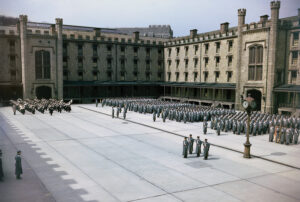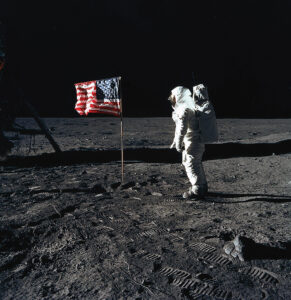The Communist defeat in the autumn of 1950 also created complex problems in categorizing the detainees. North Korean soldiers appeared easy to identify; they surrendered in uniform on the battlefield. Yet interrogators soon realized that many of them were impressed South Koreans who were not Communists (or who had made rapid reconversions to anti-Communism). Others were North Koreans, also impressed into the North Korean army, who would have fled North Korea if they could have.
South Koreans posed other problems. When the U.S. Eighth Army and five South Korean army divisions advanced across the 38th Parallel in October, they left behind the U.S. 2nd and 25th Infantry Divisions, three reconstituted South Korean divisions, and the Korean National Police in South Korea to deal with North Korean army stragglers (estimated at 10,000) and thousands of South Korean Communist Party partisans. All Communist Party members and sympathizers in South Korea became fair game. American and British soldiers-and Western journalists-witnessed mass summary executions around Seoul. For any Korean who thought he could be suspected of collaborating, surrendering to the Americans looked attractive.
The Chinese military intervention of October and November of 1950 threw the United Nations’ prisoner management into even greater confusion. As the Chinese People’s Volunteers Force liberated Pyo?ngyang from the Eighth Army and forced the U.S. X Corps and South Korean I Corps to evacuate northeastern Korea by sea, the UN Command evacuated its Pyo?ngyang POW population, along with more than 900,000 additional refugees from North Korea. No longer shooting suspected Communists-at American insistence-the Rhee government wanted refugees and POWs treated alike until their loyalty could be established. Not unreasonably, South Korean counterintelligence officers suspected that some of the refugees were Communist infiltrators and long-term moles sent to reestablish the South Korean Labor Party.
Most of the POWs and shipborne refugees went directly to Koje-do Island, with some shipped to Cheju-do Island, the traditional last bastion of Koreans against foreign invaders and the potential evacuation site for Rhee’s government. Temporarily, the rest of the POWs went to the Pusan area. At the end of December 1950, UN Command had 137,175 Koreans and 616 Chinese in custody.
The Koje-do camps, managed by the U.S. Army 3rd Logistical Command, had been evacuated directly from the areas of Inchon and Seoul. The first 53,588 Korean POWs built their own camps, primarily tents and wooden barracks. Even though UN Command’s military fortunes began to improve by February 1951, the UN Command jailors continued transferring POWs to Koje-do because of threats of guerrilla raids and jailbreaks. By March, 28 different Koje-do compounds had become the home of 139,796 captives, mostly North Koreans-and far more than their intended maximum capacity. The Pusan camps held 8,000 hospital patients, 420 political figures, 2,670 high-ranking officers, 3,500 intelligence targets, and 2,500 administrative and medical personnel.
Because the POWs still seemed docile and cooperative, the camps remained undermanned with ill-trained, poorly armed guards: one South Korean guard for every 26 prisoners and one American guard for every 200-plus prisoners. The POWs and civilian refugees mingled daily while constructing the camp, cooking, and disposing of waste. More refugees served as clerical and medical personnel and interrogator-translators. The camp administrators, focused on short-term management challenges, judged the prisoners cooperative. The Red Cross reported the camps minimally acceptable. A joint U.S.-Korean counterintelligence team warned, however, that the North Korean POW population included a large group of Communist militants capable of violent resistance to the UN Command prison policies.
Three Korean POWs later emerged as leaders of the resistance movement. Sr. Col. Yi (or Lee) Hak-ku had led a mutiny against the commander of the North Korean army’s 13th Division, who would not surrender his battered, helpless division, trapped north of the Pusan Perimeter. Division Chief of Staff Lee had shot (but not killed) that commander and fled to Eighth Army lines with his division’s classified documents. He requested a transfer to the South Korean army, which was denied. Off he went to a prison pen, knowing his former employer, North Korea, would put him to death if he returned home.
Sr. Col. Hong Chol, an intelligence officer, had also been cooperative on surrender, and may have surrendered on purpose, to organize the camps. Pak Sang-hyon, the ultimate commander of the Koje-do resistance, a civilian and Soviet citizen, had been born and raised in the Asian Soviet Union, where his family of radical nationalists had found refuge from the Japanese. He became a full-fledged member of the Communist Party USSR in 1940.
In 1945 Pak joined the Red Army (unwillingly) as a Korean language interpreter, with the nominal rank of captain, for the Soviet invasion of Manchuria and northern Korea. He became vice chairman of the North Korean Labor Party’s branch in rich, populous, and unhappy Hwanghae Province, south of Pyo?ngyang. In October 1950, even before the advancing Eighth Army arrived, Pak fled his station. In the crisis, North Korean leader Kim Il-sung decreed summary execution to any Communist Party member who tore up his party card and deserted his post. To avoid being shot, Pak surrendered to an American patrol on October 21, 1950, in the uniform of a North Korean army private.
Three UN Command initiatives in 1950 and 1951 contributed to the ballooning of the resistance movement among the Communist prisoners of war: an effort to reduce epidemic gastrointestinal diseases among the POWs; the political-religious reeducation programs conducted for the POWs; and the investigation into war crimes committed by the North Koreans and Chinese. None of these UN Command programs alone was responsible for the resistance movement, but all provided extra opportunities for the Communists to reduce UN Command access to the POWs, as Communist planners turned the POWs into weapons of warfare.
Jailors’ access to their prisoners was the issue at the heart of the violence that was about to envelop Koje-do. American and South Korean prison authorities needed access to the prisoners to determine if they wanted to be repatriated to North Korea or China after the war ended.
But the Communist leaders, both in China and in North Korea, sought to prevent embarrassing mass defections to South Korea or Formosa. So they decided to try to force the UN Command to abandon any sort of screening process, thereby prolonging the war and undermining U.S.-South Korean relations.
Given the primitive conditions and overcrowding of the Koje-do prison complex in early 1951, the UN Command’s public health doctors were not surprised when dysentery, diarrhea, and a variety of enteric fevers broke out in epidemic proportions. The key figure in treating the fevers was a U.S. Navy physician, Lt. Gerald A. Martin. Jerry Martin’s medical training in the United States was first-rate, and his family had been medical missionaries in Korea for two generations. His father, Dr. Stanley H. Martin, had been a prominent staff physician at Seoul’s Severance Hospital, Korea’s preeminent medical center.
Jerry Martin, who spoke Korean, rallied Korean Christian doctors, nurses, and technicians from Severance Hospital to establish a major clinic at Koje-do in May 1951. After identifying different strains of parasitic diarrhea, Martin and his staff developed different treatment regimes that cured many of the stricken POWs.
Martin’s fame spread from Koje-do to Korea and to Japan through his military sponsors, the United Nations Civil Assistance Command and Far East Command’s Civil Intelligence and Education Service (CI&E), a program ostensibly for educating POWs about life outside China and North Korea, but in essence an indoctrination program that promoted democracy and Christianity. One of the program’s most effective representatives was the Rev. Edwin W. Kilbourne, Martin’s brother-in-law.
The Communists, however, charged that Martin was conducting germ warfare experiments in the same spirit of Japan’s heinous Unit 731 during World War II. Communist propagandists in Pyo?ngyang condemned Martin as a war criminal even before they announced that the UN Command had waged a bacteriological warfare campaign in Korea and China. They especially focused on an inoculation program Martin’s staff of medical “researchers” had begun for the POWs.
By the autumn of 1951, the public health teams found it harder and harder to reach the POWs; some even attacked them in the compounds. Providing effective medical treatment had become a battleground for the hearts and minds of the POWs.
[continued on next page]




